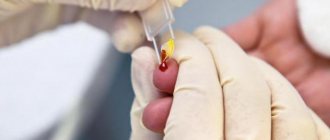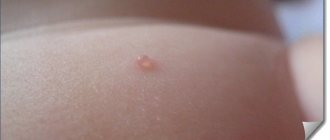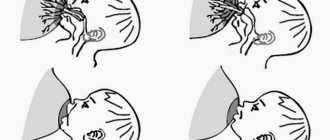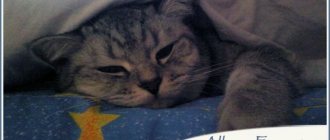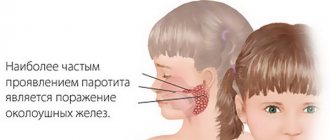The birth of a healthy baby is the greatest happiness for his parents. But it also happens that already in the first days after its birth, the baby makes its mother and father thoroughly worried. They notice that the head of their beloved little one is constantly turned to one side. And, when trying to change its position, the baby feels discomfort, and a painful grimace appears on his face. If you contact your local pediatrician with similar symptoms, he will probably make a diagnosis of muscular torticollis. And he will refer the baby for a consultation with a pediatric orthopedist-traumatologist. To understand what kind of disease this is, you can’t do without an anatomy lesson.
Torticollis in newborns: what is it?
Behind the lower edge of the auricle we have a tubercle. In the area of this tubercle, a muscle begins, which is attached with its two legs in the area of the collarbone and in the upper third of the sternum. This muscle in humans is responsible for tilting and turning the head in the opposite direction. And its name speaks for itself. After all, this muscle is called the sternocleidomastoid muscle or the sternocleidomastoid muscle.
If, for some reason, the sternocleidomastoid muscle is damaged, the child’s head tilts towards it and, at the same time, turns in the opposite (healthy) direction. This is how muscular torticollis manifests itself in newborns.
Muscular torticollis: causes
Muscular torticollis is a forced unnatural position of a child’s head, the causes of which can be both congenital and acquired pathologies.
The most common ones are:
- Incorrect position of the fetus and various complications during pregnancy.
- Compression of the neck during childbirth (in the case of entanglement in the umbilical cord, for example), birth injuries to the neck.
- Congenital developmental pathology.
- Oxygen starvation of the fetal brain or prolonged hypoxia during childbirth can cause increased tone of the sternocleidomastoid muscle of the newborn.
Causes of high blood pressure
Before you begin to understand the causes of intracranial turgor in a child and what the signs of this disease are, you need to find out what exactly it is? How does increased ICP manifest in children and what treatment is needed for this disease?
The brain does not hang in the child’s skull by itself, it is in a liquid called cerebrospinal fluid, the main function of which is to protect this vital organ from injury and concussion. Naturally, like any liquid, cerebrospinal fluid puts pressure on the child’s internal organs. This is intracranial pressure in infants, which in some cases can be increased; in such situations, a simple massage often helps.
When an increase in the impact of cerebrospinal fluid on the child’s skull is constantly observed, you should contact a neurologist without waiting for complications that can affect not only the children’s brain, but also other organs. They should be treated.
High cranial pressure in newborns is a symptom that signals changes in the child’s body that require treatment, says pediatric therapist Evgeniy Olegovich Komarovsky.
Here is a list of diseases that provoke an increase in ICP in children against the norm, and which need to be treated:
- meningitis, especially purulent;
- encephalitis;
- toxic cerebral edema;
- hydrocephalus;
- subdural hematomas;
- acute fetal hypoxia;
- various traumatic brain injuries.
In 9 out of 10 cases, intracranial turgor in infants increases as a result of birth injuries or intrauterine diseases. A factor due to which intracranial clenching may increase in infants may be a violation of the circulation of cerebrospinal fluid. In this case, massage turns out to be effective.
Torticollis in an infant: signs of torticollis
As a rule, the first signs of this disease can be noticed only 6-14 days after the birth of the child. In addition to the unnatural rotation of the baby's head, where the sternocleidomastoid muscle is located, you can find a small lump (1-3 cm in size). The muscle itself, to the touch, is hardened. It seems noticeably shorter than the second one, it is symmetrical.
If you notice similar symptoms in your baby, be sure to consult a doctor. Only he is able to make an accurate diagnosis. After all, muscular dystonia can also manifest itself. It is much easier to treat than torticollis, the therapy of which is complex and long-term.
Torticollis: photo
Diagnostics
There are several ways to make a diagnosis:
- Physical examination - the pediatrician palpates the neck muscles and visually assesses the position of the baby's head. This method can easily detect the disease before 5 months of age.
- X-ray is a way to confirm the diagnosis. To clarify the clinical picture, the attending physician may send the child for a computed tomography or MRI.
- Electroneurography is a diagnostic method that is performed if a child is suspected of having neurogenic torticollis.
Symptoms alone are not enough to make a diagnosis, so if a pathology is suspected, the doctor prescribes a comprehensive examination. Each type of torticollis has its own detection method:
- Physical method. The doctor visually assesses changes in the child’s physiology, palpates the neck and checks its pain in different positions of the head.
- Radiography. Used to confirm the diagnosis and establish the nature of torticollis. The specialist may also order a CT or MRI for a more accurate picture.
- Electroneurography. It is carried out when a child is suspected of having a neurogenic type of illness.
Up to 5 months of age, it is easy to diagnose pathology in children using the physical method at a regular examination by a pediatrician. When making a diagnosis, a number of tests are often required.
Torticollis: treatment
The best results in the treatment of muscular torticollis in infants can be achieved using several methods of therapy simultaneously.
First, the baby is prescribed physical therapy and massage, as well as positioning therapy. And from 1-1.5 months you can add:
- Electrophoresis (with lidase or potassium iodide solution).
- Paraffin applications.
- Thermal procedures before massage sessions.
The baby's head must be constantly maintained in a physiological position (using an orthopedic pillow or a Shants collar). To do this, parents can make a collar bandage themselves (or under the guidance of a physical therapy specialist). You can purchase such a collar ready-made, or have it made to order at a prosthetics factory.
General recommendations for your baby
Soft mattresses and high pillows are prohibited . The child should sleep on a hard mattress. Buy an orthopedic pillow and only that.
If the baby's neck is turned to one side for a long time, you need to change its position. , the correct position of the baby is very important : the shoulders and head should form the letter “T”; if necessary, correct the position of the body using bags of the most common fine sand, which can be found anywhere.
From the age of seven months, a child with torticollis wears a Shants collar.
Torticollis is not a death sentence . Modern medicine has learned to treat it successfully. The mission of parents is to notice alarming symptoms in time and consult a doctor, and then regularly perform exercises and massage.
Massage for torticollis and therapeutic exercises
The most effective treatment for torticollis in infants is massage. It is best to entrust its implementation to a specialist in this field.
But you can also conduct massage sessions and therapeutic exercises on your own, at home, with certain preparation. The main thing is to clearly understand what you are doing and why.
Here are a few exercises that you can do for your baby yourself. All of them are aimed at gradually stretching the sternocleidomastoid muscle. Some movements can be quite painful for the child. Perform them carefully, without using force.
And remember: only regular daily exercises and procedures in the treatment of muscular torticollis in newborns can give a positive result.
- The first exercise is best done together. Let, for example, it be the baby’s mother and father. The father should place the child on the table face up so that the lower part of his body, up to the shoulder girdle, is on the table, and the neck and head hang down. At the same time, the mother supports the baby’s head. Then, alternately, he gently bends it back along the midline and puts his chin forward. You need to try to ensure that the baby's head hangs under its own weight. At the same time, the sternocleidomastoid muscle relaxes and gradually stretches. The exercise should be repeated 4-8 times.
- Second exercise. The starting position is similar. The mother supports the baby's head with both hands on the sides and tilts it towards the healthy sternocleidomastoid muscle. It is advisable that the child's ear reaches his shoulder. The tilt is repeated 3 times, then you need to try to gently, without causing pain, tilt the baby’s head in the opposite direction as far as possible. Strictly observe the ratio of tilts to the “sick” and “healthy” sides - 1:3. We repeat the exercise 4-8 times.
- The third exercise is also aimed at gradually stretching the sternocleidomastoid muscle. The starting position is the same as in exercise No. 1. But the child lies not on his back, but on his healthy side. The mother supports the baby's head with her palm. She gradually lowers her hand down. At the same time, its support weakens, and the baby’s head, again, hangs on its own, but to the side, stretching the affected muscle with its weight. We also repeat 4-8 times.
As for massage for torticollis in a child, as they say, it’s better to see once...
Torticollis in a child: massage for torticollis (video)
Symptoms of hypertension
Video:
Complications during pregnancy, birth injuries, Rhesus conflict, incompatibility of the parents' blood, residence in a poor environmental situation and many other reasons will be a prerequisite for the appearance of hypertension. It is worth paying close attention to the symptoms of hypertonicity, because this can be an expression of a severe neurological disease.
Signs of severe hypertension:
- Restless and short sleep.
- In the lying position, the head is thrown back, and the arms and legs are tucked.
- When trying to separate the baby's legs or arms, powerful resistance is felt. The child is crying. Secondary dilution increases muscle resistance.
- Vertically on a hard surface, the child tries to stand on the front part of the foot, that is, stands on tiptoes (Information: if the child walks on tiptoes).
- When crying, the child throws his head back, arches, and at the same time his chin muscles tremble (See the article on chin tremor).
- Frequent regurgitation.
- Painful reaction to various stimuli: light, sound.
- From birth, the baby “holds” his head due to the constant tension of the neck muscles.
Muscle hypertonicity is determined by several reflex tests:
- Sitting by the hands: It is impossible to take the baby's hands away from the breast.
- Step reflex. In an upright position, the child ( in the basic sense, a person during childhood
) seems to be trying to take a step. It persists after 2 months. - Support reflex: a standing child leans on his toes.
- Preservation of asymmetric and symmetric reflexes after 3 months. When the baby's head is tilted to the chest while lying on his back, his arms bend and his legs straighten. When turning the head to the left in the same position, the left arm stretches forward, the left leg extends, and the right leg bends. When you tilt to the right, everything is repeated in a mirror image.
- Preservation of the tonic reflex after 3 months: lying on his back, the child straightens his limbs, and bends them on his tummy.
If by a certain age these reflexes do not weaken and do not disappear in the future, this means that the baby has pronounced muscle hypertonicity. Therefore, you need to see a doctor.
Carefully about newborn reflexes
Consequences and danger
Why is hypertonicity so unsafe if its appearance is justified by the very position of the fetus? Physiological hypertonicity disappears without a trace after 3 months. Pathological hypertonicity is caused by damage to the brain tissue that is responsible for the condition of the muscles. Such violations ( Offence, action or inaction, contrary to the requirements of legal norms and committed by a person capable of delinquency; “Violation”, one of the first stories by Sergei Lukyanenko
) appear with increased intracranial pressure, perinatal encephalopathy, increased excitability and other pathologies.
hypertonic muscle
If hypertonicity in children persists after 3 months, the consequences, in the absence of treatment, are disastrous. Lack of regulation of muscle tone will affect the future development of the baby:
- Impaired coordination of movements;
- Formation of an incorrect gait;
- Incorrect formation of posture;
- Developmental delays, especially motor abilities;
- Speech impairment.
Hypertonicity of the legs
It is especially unsafe if the baby develops severe hypertonicity in the legs. It affects the rate of development of motor activity. Children with this diagnosis later begin to crawl and walk. For children with hypertonic legs, the use of walkers and jumpers is especially contraindicated. These devices enhance the state of muscle tension ( or muscles (from the Latin musculus - “muscle”) - organs consisting of muscle tissue; capable of contracting under the influence of nerve impulses
) legs and spine due to uneven distribution of gravity. Overload increases specifically on the muscles of the pelvis and spine.
Hypertonicity of the arms
Hypertonicity of the arms is expressed in muscle resistance when moving the arms away from the chest, powerfully clenched fists. This condition is most often observed with physiological hypertonicity. But long-term persistence of tension in the muscles should worry the baby’s parents.
See video:


